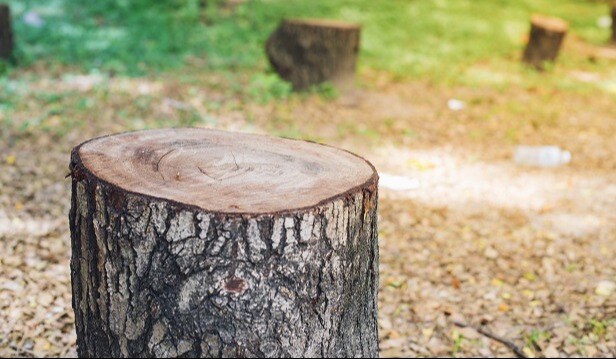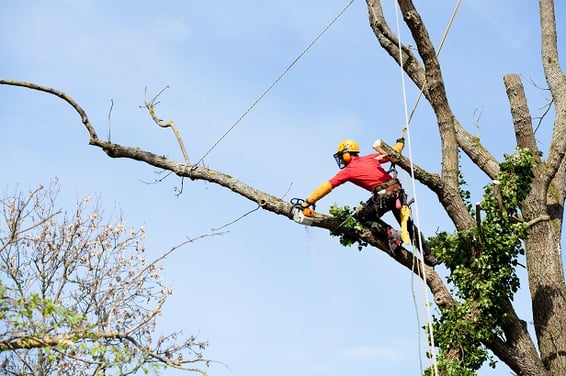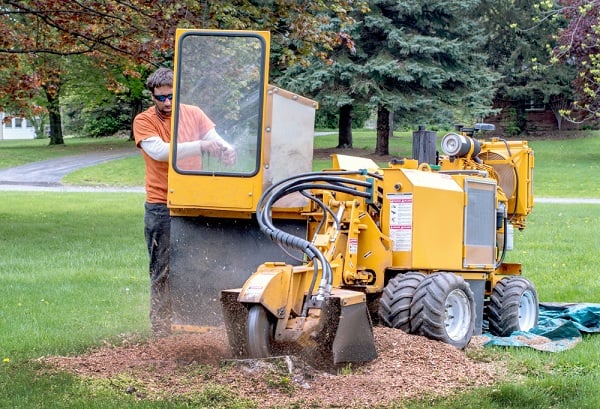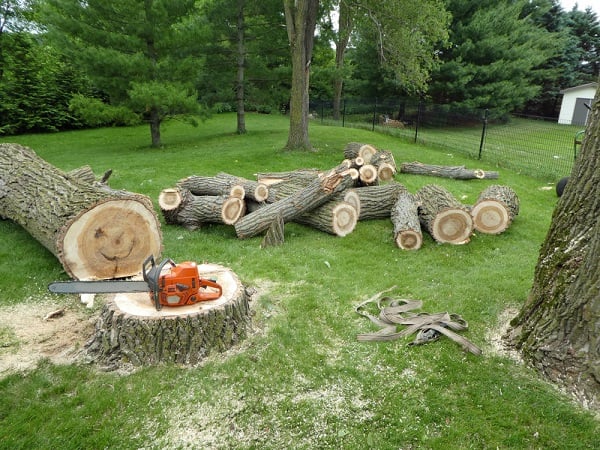
Maintaining trees is an important part of homeownership. It can protect your home and property from unwanted damage from wind, severe weather, and hurricane season. A tree may require more than regular maintenance if it dies, becomes sick, or is too big for its location or proximity to your house. If you're unsure about the health of a tree, there are ways to tell if your tree might be prone to fall. You can also consult a professional arborist who can recommend treatment or removal.
If you have a tree that needs to be removed, you may be tempted to attempt to cut it down yourself. Tree removal can be pricey. While Virginia state law has no special permit requirements or laws concerning tree removal on private property, this is one project you shouldn't DIY lightly even to save money. Our home insurance experts know a little bit about the power of trees and taking them down.
When to call a professional tree removal service
If you'll need a ladder to do the job, the tree is too big to remove it yourself. Ladders in non-occupational settings such as homes and farms cause 97% of approximately 500,000 annual falls and injuries in the U.S.(Pubmed.gov). Add in a chainsaw, leaning, tugging, and falling tree parts and you are putting your safety at serious risk. You could also be risking property damage, especially if the tree is close to your home and other structures.
Reasons why tree removal is dangerous
Tree removal is harder than it looks. Here are a few reasons why:
- Physics! Trees and their limbs are unpredictable when they fall.
- Tree limbs are much heavier than they look.
- Ladders can get knocked over by falling branches and limbs.
- A chainsaw, hand saw, or any sharp cutting tool should never be used on a ladder, where balance can come into play.
When you can remove a tree yourself
If the tree is small enough that you don't need to climb a ladder, you can most likely remove it yourself. Here are a few tips on how to cut down a small tree:
- Water it thoroughly the day before you plan your project.
- You may cut off the top of the tree and small branches, leaving enough of the trunk to grab at chest height.
- Dig around the base of the tree until you can see about a foot of major roots.
- Pull and push the tree back and forth to loosen the earth until the root ball is free.
- Be prepared to cut larger roots with a hand saw.
Can you use your truck to remove a tree?
You may be thinking of tying a tree or stump to your truck and pulling it out. Just google "Trucks vs. stumps" for pages of convincing video footage. Most standards trucks and SUVs can haul around 3,500 pounds, less than the average large tree stump by itself. With the unpredictability of a falling tree, so many things can go wrong. The chance of damaging your vehicle is high, and there's also a significant danger to the driver. Your comprehensive car insurance may cover the damage, but why take the chance on your safety?
Hiring the right professional tree removal company
Tree removal safety protocols
The only con to paying for a tree removal service is it's not cheap. It's also not the time to scrimp by hiring someone with subpar training and credentials. Hire a professional tree removal service that can provide credentials and licensing before you sign a work contract. If the company gives you a hard time, that's a red flag. Don't do business with them.
Tree work is dangerous so their insurance is important to protect you too. Be sure any tree care company you hire has general liability insurance and workers compensation insurance specifically for tree care. Ask to see a certificate of insurance (COI) directly from the insurance company. Check the expiration date and inquire to be added as an “additional insured”. Both you and your neighbor should be listed if the tree is anywhere near the property line or your neighbor's home. Minimum limits should be:
- General Liability: $1 million for each occurrence and $2 million aggregate
- Automobile Liability: $1 million for each accident
- Umbrella Liability: $1 million
- Workers Compensation: $500,000 per accident

What does it cost to remove a tree in Virginia?
The cost to professionally remove a tree can vary from $500 to over $2500 depending on size, condition, tree species, and added services. Some additional costs are unavoidable, some are optional, but all are helpful and important to the future safety of your property. Here's what to expect:
Accessibility
If the tree is located near your home, a fence, shed, another home or structure, or high voltage power lines, it will cost more due to the increased liability. The more difficult and time-consuming the job, the higher the price.
Stump grinding
After a tree is cut, it's important to remove what's left. A stump can attract insects, snakes, and fungi, which can impact other healthy trees and vegetation. It also poses a nasty tripping hazard on your property and can take away from your curb appeal. It takes special equipment and extra work, which can add cost to your tree removal.

Wood removal
Be sure your quote includes wood removal and disposal unless you plan to do it yourself. It can make great firewood. If you won't use it, ask the contractor if they will recycle the wood. You may have heard you can sell certain types of wood in exchange for removal but it's unlikely. While it won't hurt to contact local lumber mills or google local recycled wood dealers, the cost and difficulty of removing a tree are most likely going to exceed its value.

Good luck with your tree. If it happens to be your neighbor with the troublesome tree, there are things you can try to resolve the problem. It's best to avoid a scenario where your neighbor's tree falls on your property or vice-versa whenever possible. Rest assured, your home insurance protects you against tree damage in the event something does go wrong during bad weather or otherwise.
Learn more about homeowners insurance in Virginia >
THE NORTHERN NECK INSURANCE INTEGRITY PROMISE — We pledge to provide straight talk and good counsel from our NNINS Virginia insurance experts through our blog. While we hope you find this to be a helpful source of information, it does not replace the guidance of a licensed insurance professional, nor does it modify the terms of your Northern Neck Insurance policy in any way. All insurance products are governed by the terms in the applicable insurance policy.


